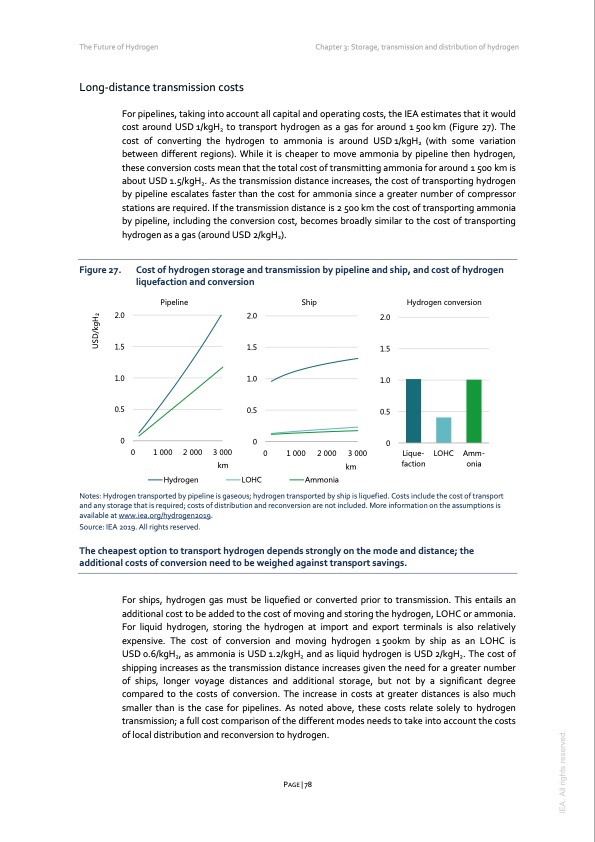
PDF Publication Title:
Text from PDF Page: 078
The Future of Hydrogen Chapter 3: Storage, transmission and distribution of hydrogen Long-distance transmission costs For pipelines, taking into account all capital and operating costs, the IEA estimates that it would cost around USD 1/kgH2 to transport hydrogen as a gas for around 1 500 km (Figure 27). The cost of converting the hydrogen to ammonia is around USD1/kgH2 (with some variation between different regions). While it is cheaper to move ammonia by pipeline then hydrogen, these conversion costs mean that the total cost of transmitting ammonia for around 1 500 km is about USD 1.5/kgH2. As the transmission distance increases, the cost of transporting hydrogen by pipeline escalates faster than the cost for ammonia since a greater number of compressor stations are required. If the transmission distance is 2 500 km the cost of transporting ammonia by pipeline, including the conversion cost, becomes broadly similar to the cost of transporting hydrogen as a gas (around USD 2/kgH2). Figure 27. 2.0 1.5 1.0 0.5 Cost of hydrogen storage and transmission by pipeline and ship, and cost of hydrogen liquefaction and conversion Pipeline Ship Hydrogen conversion 2.0 1.5 1.0 0.5 2.0 1.5 1.0 0.5 0 00 0 1 000 2 000 Hydrogen 3 000 km 0 1 000 2 000 3 000 km Lique- LOHC Amm- LOHC Ammonia Notes: Hydrogen transported by pipeline is gaseous; hydrogen transported by ship is liquefied. Costs include the cost of transport and any storage that is required; costs of distribution and reconversion are not included. More information on the assumptions is available at www.iea.org/hydrogen2019. Source: IEA 2019. All rights reserved. The cheapest option to transport hydrogen depends strongly on the mode and distance; the additional costs of conversion need to be weighed against transport savings. For ships, hydrogen gas must be liquefied or converted prior to transmission. This entails an additional cost to be added to the cost of moving and storing the hydrogen, LOHC or ammonia. For liquid hydrogen, storing the hydrogen at import and export terminals is also relatively expensive. The cost of conversion and moving hydrogen 1 500km by ship as an LOHC is USD 0.6/kgH2, as ammonia is USD 1.2/kgH2 and as liquid hydrogen is USD 2/kgH2. The cost of shipping increases as the transmission distance increases given the need for a greater number of ships, longer voyage distances and additional storage, but not by a significant degree compared to the costs of conversion. The increase in costs at greater distances is also much smaller than is the case for pipelines. As noted above, these costs relate solely to hydrogen transmission; a full cost comparison of the different modes needs to take into account the costs of local distribution and reconversion to hydrogen. faction onia PAGE | 78 IEA. All rights reserved. USD/kgH2PDF Image | The Future of Hydrogen 2019

PDF Search Title:
The Future of Hydrogen 2019Original File Name Searched:
the_future_of_hydrogen.pdfDIY PDF Search: Google It | Yahoo | Bing
NFT (Non Fungible Token): Buy our tech, design, development or system NFT and become part of our tech NFT network... More Info
IT XR Project Redstone NFT Available for Sale: NFT for high tech turbine design with one part 3D printed counter-rotating energy turbine. Be part of the future with this NFT. Can be bought and sold but only one design NFT exists. Royalties go to the developer (Infinity) to keep enhancing design and applications... More Info
Infinity Turbine IT XR Project Redstone Design: NFT for sale... NFT for high tech turbine design with one part 3D printed counter-rotating energy turbine. Includes all rights to this turbine design, including license for Fluid Handling Block I and II for the turbine assembly and housing. The NFT includes the blueprints (cad/cam), revenue streams, and all future development of the IT XR Project Redstone... More Info
Infinity Turbine ROT Radial Outflow Turbine 24 Design and Worldwide Rights: NFT for sale... NFT for the ROT 24 energy turbine. Be part of the future with this NFT. This design can be bought and sold but only one design NFT exists. You may manufacture the unit, or get the revenues from its sale from Infinity Turbine. Royalties go to the developer (Infinity) to keep enhancing design and applications... More Info
Infinity Supercritical CO2 10 Liter Extractor Design and Worldwide Rights: The Infinity Supercritical 10L CO2 extractor is for botanical oil extraction, which is rich in terpenes and can produce shelf ready full spectrum oil. With over 5 years of development, this industry leader mature extractor machine has been sold since 2015 and is part of many profitable businesses. The process can also be used for electrowinning, e-waste recycling, and lithium battery recycling, gold mining electronic wastes, precious metals. CO2 can also be used in a reverse fuel cell with nafion to make a gas-to-liquids fuel, such as methanol, ethanol and butanol or ethylene. Supercritical CO2 has also been used for treating nafion to make it more effective catalyst. This NFT is for the purchase of worldwide rights which includes the design. More Info
NFT (Non Fungible Token): Buy our tech, design, development or system NFT and become part of our tech NFT network... More Info
Infinity Turbine Products: Special for this month, any plans are $10,000 for complete Cad/Cam blueprints. License is for one build. Try before you buy a production license. May pay by Bitcoin or other Crypto. Products Page... More Info
| CONTACT TEL: 608-238-6001 Email: greg@infinityturbine.com | RSS | AMP |